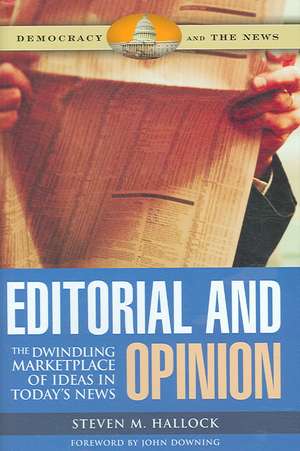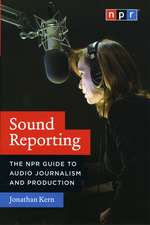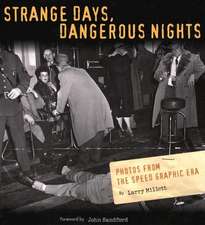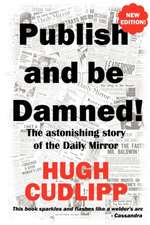Editorial and Opinion: The Dwindling Marketplace of Ideas in Today's News
Autor Steven M. Hallocken Limba Engleză Hardback – 29 noi 2006 – vârsta până la 17 ani
Preț: 321.44 lei
Preț vechi: 392.00 lei
-18% Nou
Puncte Express: 482
Preț estimativ în valută:
61.52€ • 63.99$ • 50.78£
61.52€ • 63.99$ • 50.78£
Carte tipărită la comandă
Livrare economică 14-28 aprilie
Preluare comenzi: 021 569.72.76
Specificații
ISBN-13: 9780275993306
ISBN-10: 0275993302
Pagini: 224
Dimensiuni: 156 x 235 x 21 mm
Greutate: 0.49 kg
Editura: Bloomsbury Publishing
Colecția Praeger
Locul publicării:New York, United States
ISBN-10: 0275993302
Pagini: 224
Dimensiuni: 156 x 235 x 21 mm
Greutate: 0.49 kg
Editura: Bloomsbury Publishing
Colecția Praeger
Locul publicării:New York, United States
Notă biografică
Steven M. Hallock is Assistant Professor of Journalism at Southern Illinois University in Carbondale. He is a 30-year veteran newspaper journalist, serving most recently as managing editor of three daily newspapers in Ohio. He has been an editorial page editor, features editor, and writer at newspapers in Pennsylvania, Oklahoma, New Mexico, Texas, Idaho, Arizona, and Wyoming.
Recenzii
The number of competing major newspapers has shrunk from 288 in 1930 to fewer than 30 today, and this makes media watchers suspect that something important is lacking in the marketplace of ideas that protects a free society. Hallock confirms that suspicion here, first establishing a historical framework and then analyzing newspaper editorials past and present to establish their effectiveness. Scrupulously researched and packed with statistical charts and graphs, this book takes to task the bland, homogenized editorial offerings of the present era, demonstrating ways in which the corporate model for news diminishes public debate and dilutes the exchange of ideas in American society. Replete with examples of robust, informed opinion writing that arose from local competition in newspapers of the past, this volume in the Democracy and the News series makes a convincing argument in favor of strong, competing editorial voices that promote vital debate, shape public opinion, and set the political agenda for communities and the nation..[a]dds solid support in favor of independent and competitive media outlets. Highly recommended. Upper-division undergraduates through faculty and professionals.
Hallock's book examines the content of editorial opinion pages to analyze how this shrinking marketplace affects the diversity of ideas, agendas and opinions available for public consideration.
Hallock analyzes the content of historical and modern US newspaper editorials in order to investigate how newspaper market competition influences the opinions that appear on the editorial pages. His analysis focuses on the differences and similarities of editorial production in direct competition markets (Boston and Chicago), joint operating agreement markets (Seattle and Denver), and metroplex markets (Dallas/Fort Worth and Pittsburgh/Greensburg), with separate chapters exploring the general contours of each and an additional chapter analyzing editorial treatment of the 2004 presidential campaign for all three markets.
Hallock's book examines the content of editorial opinion pages to analyze how this shrinking marketplace affects the diversity of ideas, agendas and opinions available for public consideration.
Hallock analyzes the content of historical and modern US newspaper editorials in order to investigate how newspaper market competition influences the opinions that appear on the editorial pages. His analysis focuses on the differences and similarities of editorial production in direct competition markets (Boston and Chicago), joint operating agreement markets (Seattle and Denver), and metroplex markets (Dallas/Fort Worth and Pittsburgh/Greensburg), with separate chapters exploring the general contours of each and an additional chapter analyzing editorial treatment of the 2004 presidential campaign for all three markets.












